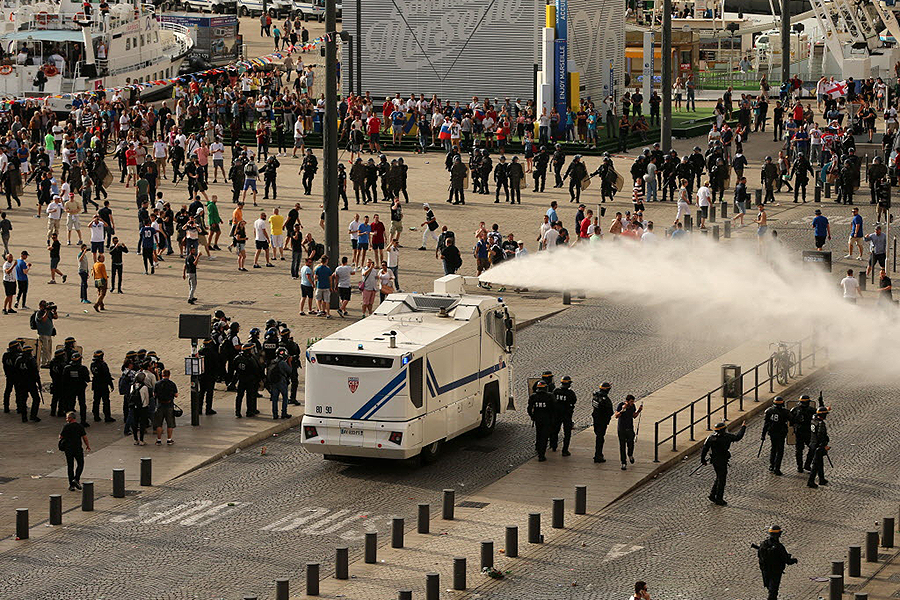Russia fined as soccer seeks strategies against Euro 2016 fan violence
Loading...
Russia's soccer team has been warned that it faces disqualification if its fans erupt into violence again at the Euro 2016 tournament, authorities announced Tuesday, levying a $170,000 fine on the country's soccer federation after clashes following a match between Russia and England on Saturday.
The Union of European Football Associations' (UEFA) penalties, which Russia protested as "extremely severe," are part of an attempt to clamp down on fan conflicts that have long shaped soccer culture and added extra safety concerns to high-profile events already anxious about security.
UEFA had warned both nations that the teams would face disqualification if there were further violence from their fans, according to The Washington Post. On Tuesday, the governing body imposed a suspended disqualification on Russia and said that the suspension would be enforced if "incidents of a similar nature" recur.
Violence erupted Saturday after the 1 to 1 draw in Marseille, France, as Russian fans set off flares in the stands and others climbed across barriers between the nations' fans to instigate a fight. 35 people were injured, and 20 arrested. Marseille prosecutor Brice Robin blamed 150 Russian "hooligans" whom he called "well prepared for ultra-rapid, ultra-violent action," according to the BBC.
Over the weekend, UEFA announced it would strengthen security at matches, and host country France announced it would ban the sale of alcohol in "sensitive" areas near venues. Experts say increasing security at matches and enacting alcohol bans are just two of the multiple ways that local authorities are trying to limit fan-on-fan violence.
Modern "football hooliganism" started in England in the 1960s when matches became televised and thereby more accessible to the working class, replacing a more aristocratic fanbase, write the co-authors Peter Marsh and Steven Frosdick in "Football Hooliganism."
Jerry Lewis, a professor emeritus of sociology at Kent State University in Ohio, whose research has focused primarily on stadium violence in the United States, tells The Christian Science Monitor that fans who commit violence at matches typically fall under the same profile.
"There's a certain type of fan, a young, white male, typically, who identifies very strongly with the team but they can't kick a football 50 yards or score goals," he says. "So they commit violence as a skill which helps them identify with the team."
Soccer violence in Europe has been escalating, fed in part by the continent's economic woes, The Wall Street Journal reported in 2015. Michel Platini, then the president of UEFA, told the Journal that in recent months he had been "struck by certain images that I thought were things of the past" and warned against a return to "a past where hooligans of all manner of fanatics called the shots in certain European stadiums."
Countries around the world have taken different steps to address fan violence. Turkey's football association made waves in 2011 for banning men from games involving teams sanctioned for violent fan behavior, allowing only women and children under the age of 12 to be admitted.
British authorities have generally taken reactive approaches to football violence, according to Dr. Marsh and Dr. Frosdick's 2005 book, from increasing policing and surveillance to separating fans and restricting alcohol. Dutch, German, and Belgian authorities developed more proactive schemes that deployed social workers to "coach" fans, they wrote.
In France, authorities have assigned an extra 4,000 police to Lille, the site of England's next match on Thursday. Shops selling alcohol will be closed until Friday, while around 350 bars will close early on Wednesday and Thursday, the BBC reported.
Yet some experts have questioned similar strategies' effectiveness. Marsh and Frosdick's work, for example, wrote that alcohol is not considered a major contributor to stadium violence, a view Mr. Lewis agrees with, saying he did not find drinking to be a major factor in his research of college and professional sports riots in the United States.
A guide on spectator violence in stadiums published by the Center for Problem-Oriented Policing lays out a variety of further possible solutions, including creating access barriers between different sections of the stadium, removing or refusing entrance to troublemakers and inebriated spectators, screening items brought into the stadium, advertising the punishments for violent behavior, and increasing the visibility of security.
A lot of fan violence occurs outside stadiums, however, making it touch to eradicate, Lewis says.
"Frankly, there's not much more they can do than putting out a strong police presence," he says.






